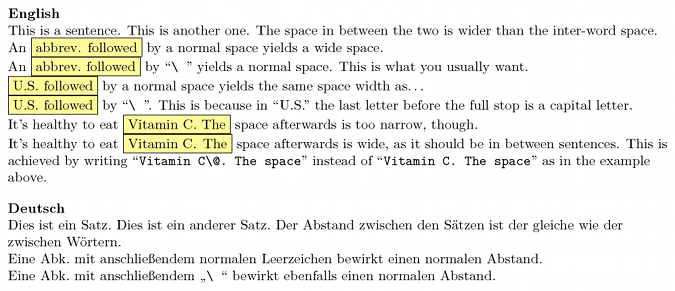When writing English text, LaTeX adds a larger space after the end of a sentence than between words. This is in accordance with local typographic standards. Things get complicated when you let a machine decide what exactly makes up the end of a sentence.
Obviously for a sentence to end a full stop is required so this is what LaTeX looks for. However, a period might also appear after the initials of a name, as in J. D. Salinger. Since initials are written using uppercase letters, LaTeX is able to deduce that a period after a capital letter actually does not mean the end of a sentence, thus the space afterwards has the regular inter-word width.
Problems appear once you actually do have a capital letter at the end of a sentence which does not get interpreted as the end of the sentence and therefore the space afterwards is more narrow than it should be.
It’s healthy to eat Vitamin C. The start of the next sentence is too close to the last one because LaTeX doesn’t interpret the period after the uppercase C as the end of a sentence.
To circumvent this problem you have to write ...Vitamin C\@. The start...
You’re probably much more likely to use an abbreviation like Mr. or etc. in a text than writing a capital letter in front of a full stop. Most abbreviations end in a lowercase letter in front of a period. Since most sentences also end the same way LaTeX assumes each of those abbreviations end a sentence. As a result you get a wide space even though the abbreviation appears in the middle of a sentence which calls for regular inter-word spacing.
An abbrev. that appears in the middle of a sentence produces a wide space right behind it because LaTeX erroneously interprets the period after a lowercase letter to signify the end of a sentence.
In order to remedy this problem you have to explicitly mark the space behind the abbreviation as \ (that is a backslash followed by a space). If an abbreviation actually is the last word in a sentence it is of course required not to use the backslash-space construct.
For those of you who don’t typeset English but i.e. German text, you don’t have to care about the above. In German typography you don’t have a wider space in between sentences than in between words. The detection of sentence endings and subsequent wider spaces are enabled by the command \usepackage[english]{babel} and disabled by \usepackage[ngerman]{babel}.
The picture below illustrates the different space widths. To ease comparison, the relevant parts are put inside yellow boxes.
